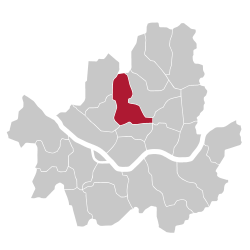Jongno-gu
|
Jongno 종로구 |
|
|---|---|
| Autonomous District | |
| 종로구 · 鐘路區 | |

Sejong-ro looking south, fair on the pedestrian stretch
|
|
 Location of Jongno-gu in Seoul |
|
| Coordinates: 37°35′58″N 126°58′29″E / 37.59944°N 126.97472°ECoordinates: 37°35′58″N 126°58′29″E / 37.59944°N 126.97472°E | |
| Country | South Korea |
| Region | Sudogwon |
| Special City | Seoul |
| Administrative dong | 19 |
| Government | |
| • Mayor | Kim Yeong-Jong (김영종) |
| Area | |
| • Total | 23.92 km2 (9.24 sq mi) |
| Population (2010) | |
| • Total | 155,575 |
| • Density | 6,500/km2 (17,000/sq mi) |
| Time zone | Korea Standard Time (UTC+9) |
| Postal code | 03000~03299 |
| Area code | 02-300,700 |
| Website | Jongno-gu official website |
Jongno District (Jongno-gu) is a gu, or district, in central Seoul, South Korea. It takes its name from a major local street, Jongno, which means "Bell Street".
Jongno District has been the center of the city for 600 years, since it is where the Joseon dynasty established its capital city. Jongno District is commonly referred to as the face and heart of Korea because of its important roles in the politics, economics, culture, and history as the capital city. Jongno District is home to palaces in which the kings used to reside and work, such as Gyeongbok Palace, Changdeok Palace, Changgyeong Palace and Unhyeon Palace. The South Korean president's current residence, the Cheongwadae, is also located in Jongno District.
With the historical value and cultural properties, Jongno District attracts visitors' attention. These include the restored Cheonggyecheon stream, the traditional neighborhood of Insa-dong, and the Jongmyo shrine. Art Center Nabi and Gahoe Museum, a relics museum is also located in the district. A number of colleges and universities are located here; these include the main campuses of Sungkyunkwan University and Baehwa Women's College.
Jongno District is also home to Jogyesa, the chief temple of the Jogye Order of Korean Buddhism.
The area is also home to the Gwanghwamun Plaza a public open space on Sejongno and is part of the Seoul Metropolitan Government's plans for environmentally friendly renovation projects such as the Cheonggye Stream and Seoul Plaza. It is also of historical significant as the location for royal administrative buildings and features statues of the Admiral Yi Sun-sin of Joseon Dynasty and King Sejong the Great of Joseon.
...
Wikipedia
